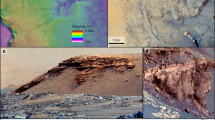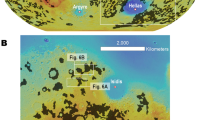Abstract
Gillespie et al.1 concur with our interpretation that certain lobate equatorial and mid-latitude features on Mars are due to debris-covered glaciers formed largely during past periods of increased spin-axis obliquity, when climate regimes favoured snow and ice accumulation and glacial flow2. They suggest that the ‘hourglass’ deposit, dated at more than 40 Myr old2, could be active today owing to an additional mechanism that supports “local augmentation of accumulation from snowfall” without climate change on Mars. This mechanism requires the present, or very recent, release of groundwater to the surface to form aufeis (groundwater-fed ‘glaciers’) where the groundwater is generated by dewatering of hydrous compounds or melting by magmatic or impact-generated heat. We assess whether this suggestion applies to the deposits in question — it was previously proposed for much older deposits in other areas of Mars3,4. We make particular reference to the key relationships in the accumulation zones.
Similar content being viewed by others
Main
Glacial accumulation zones are areas characterized by a yearly net addition of ice, and are separate from ablation zones, which undergo a yearly net loss of ice. In active valley glaciers and in the source regions for broader piedmont glaciers, the accumulation zones are commonly centred on steep-sided alcoves that provide broad traps for wind-blown snow and lie in shadow, producing colder temperatures. The accumulation zone for the hourglass deposit on Mars was thought to be the entire alcove region east and southeast of the hourglass deposit2 (Fig. 2a, b, d of ref. 2). Snow and ice accumulating in this entire alcove region probably formed distinct glaciers that moved downslope and converged to form multiple lobes, the remnants of which are seen in the upper part of the hourglass.
Changes in ice velocity, as might occur with changes in ice thickness related to deepening of bedrock topography, compressed and folded the ice, eventually merging all lobes together, then to flow through the neck of the hourglass. When climatic conditions changed, the distribution of snowfall and snow accumulation probably also changed, resulting in the cessation of ice accumulation and flow; the ice and snow deposits disappeared, and dry mass-wasting dominated, producing the talus piles superposed on top of the glacial deposits at the base of the slope (Fig. 2a–d of ref. 2, and Fig. 1a, c of ref. 1).
We therefore interpret the configuration and morphology of the lobes, as well as the abrupt contact between the base of the slope and the glacial deposits, to be a natural consequence of both the shape of the initial accumulation zone and its postglacial evolution. The candidate aufeis in the high-resolution image (Fig. 1c of ref. 1) appears morphologically similar to the floor deposits across the entire frame; we interpret its relative brightness to be due to a dust cover that was formed on the margin of the encroaching talus slope.
Nearby craters with similar scales, hourglass-like shapes, and lobate flow-like deposits (Fig. 1b of ref. 1) can also form from local crater-wall accumulation zones. In these cases, the crater interior walls are optimum locations for snow and ice accumulation, resulting in glacier-like, lobate flow down the walls and out onto the crater floor, a phenomenon that has been well documented in mid-latitude crater interiors5,6. Alcoves along crater walls create an environment favourable to the collection of snow and ice, and may provide steep cliffs that act as sources for debris that, together with ice sublimation, create debris-covered glaciers, much like those that occur in the Mars-like Antarctic Dry Valleys (Fig. 3a, b of ref. 2).
On the basis of these considerations, groundwater-fed ‘glaciers’ do not seem to be required in these locations. We agree that this mechanism should be investigated, particularly for deposits formed earlier in the history of Mars, when thermal gradients were such that groundwater may have been much closer to the surface.
References
Gillespie, A. R., Montgomery, D. R. & Mushkin, A. Nature 438, doi:10.1038/nature04357 (2005).
Head, J. W. et al. Nature 434, 346–351 (2005).
Carr, M. J. Geophys. Res. 100, 7479–7507 (1995).
Lucchitta, B. K. J. Geophys. Res. 89, suppl.B 409–418 (1984).
Howard, A. Lunar Planet. Sci. XXXIV abstr. 1065 (2003).
Marchant, D. R. & Head, J. W. 6th Int. Mars Conf. abstr. 3991 (2003).
Author information
Authors and Affiliations
Rights and permissions
About this article
Cite this article
Head, J., Neukum, G., Jaumann, R. et al. Are there active glaciers on Mars? (Reply). Nature 438, E10 (2005). https://doi.org/10.1038/nature04358
Published:
Issue Date:
DOI: https://doi.org/10.1038/nature04358
Comments
By submitting a comment you agree to abide by our Terms and Community Guidelines. If you find something abusive or that does not comply with our terms or guidelines please flag it as inappropriate.



